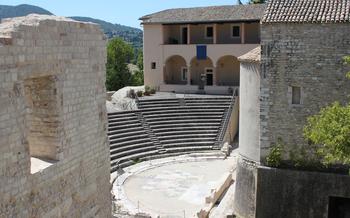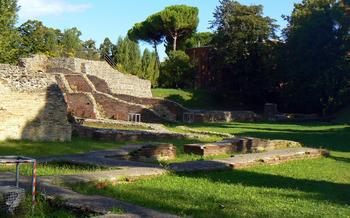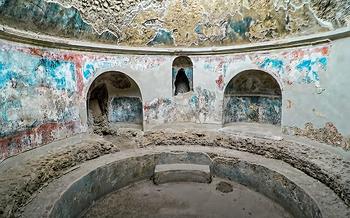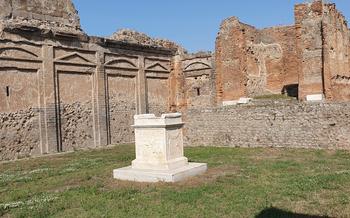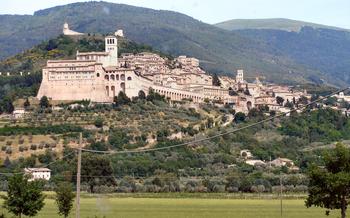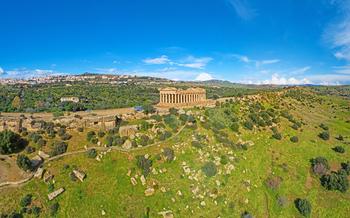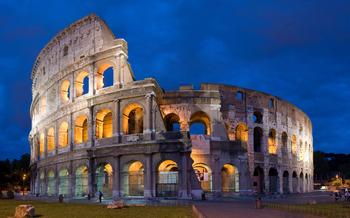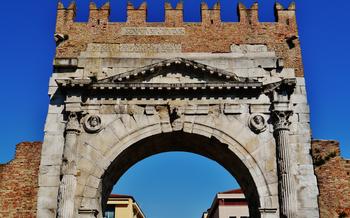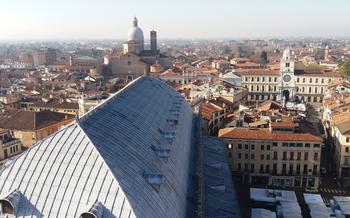
Roman Forum
- Introduction
- The Arch of Titus
- The Temple of Saturn
- Practical Information
- The Curia Julia
- The Rostra
- The Temple of Vesta
- The House of the Vestals
- The Basilica Julia
- The Temple of Julius Caesar
- The Via Sacra
- The Arch of Septimius Severus
- The Temple of Concord
- The Tabularium
- Insider Tip
Introduction
Enter the heart of ancient Rome and step into the Roman Forum, once the bustling center of political, religious, and commercial activities. This archaeological treasure trove transports you back in time, offering a glimpse into the grandeur and significance of the Roman Empire. From monumental temples and grand basilicas to triumphal arches and commemorative structures, the Roman Forum unveils the captivating history of one of the world's most influential civilizations.
Practical Information: * Address: Via della Salara Vecchia, 5/6, 00186 Roma, Italy * Operating Hours: 8:30 AM to 7:15 PM daily (last admission at 6:30 PM) * Ticket Prices: Full Price: €12; Reduced Price: €6 (for citizens of EU countries aged 18-25 and teachers of Italian state schools)
The Arch of Titus
The Arch of Titus stands as a testament to the military might and imperial grandeur of ancient Rome. Built in 81 AD to commemorate the victory of Emperor Titus over the Jewish rebels in the Jewish-Roman War, the arch is a captivating blend of historical significance and architectural artistry. Its intricate reliefs, depicting the spoils of the Jerusalem Temple, offer a glimpse into the triumphs and tragedies of the Roman Empire.
The arch's design is a marvel of engineering, showcasing the exceptional craftsmanship of the Roman builders. Its massive travertine blocks, meticulously carved and assembled, create a sense of solidity and permanence. The central arch, framed by two smaller arches, provides a grand entrance that invites visitors to step back in time and imagine the tumultuous events that unfolded here over two millennia ago.
Situated at the eastern end of the Roman Forum, the Arch of Titus serves as a gateway to the heart of the ancient city. As you approach the arch, take a moment to admire the intricate details of its carvings, which depict scenes of Roman soldiers carrying away treasures from the Temple of Jerusalem. These reliefs offer a poignant reminder of the destruction and suffering that accompanied Rome's military conquests.
When you pass through the arch, you will find yourself immersed in the vibrant atmosphere of the Roman Forum, surrounded by the ruins of ancient temples, basilicas, and government buildings. Let the Arch of Titus transport you to a time when Rome ruled the world, and experience the echoes of history that still linger in this iconic landmark.
The Temple of Saturn
The Temple of Saturn, one of the most significant and well-preserved temples within the Roman Forum, stands as a testament to the enduring legacy of the ancient Roman Empire. Built in the 6th century BC, the temple underwent several reconstructions and modifications throughout the centuries. Its current structure, dating back to the 4th century AD, showcases a blend of architectural styles and historical significance.
The eight iconic columns, towering over the ruins, are a striking feature of the temple. Originally made of African marble, they now stand in Cipollino marble, reflecting the restorations carried out during the reign of Emperor Diocletian. The well-preserved frieze, adorning the entablature above the columns, depicts various mythical scenes and historical events. These intricate carvings provide a glimpse into the rich iconography of ancient Rome.
The temple served as a treasury for the Roman state, housing the public funds and reserves of gold and silver. In addition to its financial significance, the Temple of Saturn was closely associated with the cult of Saturn, the Roman god of agriculture and time. The festival of Saturnalia, celebrated in December, marked the end of the agricultural year and featured widespread feasting and merrymaking.
Practical Information
- Location: The Temple of Saturn is situated on the north side of the Roman Forum, adjacent to the Curia Julia.
- Accessibility: The temple is wheelchair accessible via ramps and elevators, ensuring inclusivity for all visitors.
- Guided Tours: Consider joining a guided tour of the Roman Forum to gain deeper insights into the history and significance of the Temple of Saturn and other ancient landmarks.
The Curia Julia
The Curia Julia, also known as the Senate House, was the meeting place of the Roman Senate, the governing body of the Roman Republic and Empire. Built in 44 BC by Julius Caesar and completed by Augustus after Caesar's assassination, the Curia Julia replaced the earlier Curia Hostilia, which had been destroyed by fire. The Senate, composed of elder statesmen and former officials, played a crucial role in Roman governance, debating and passing laws, overseeing financial matters, and conducting foreign policy.
The Curia Julia, with its distinctive square shape and well-preserved remains, stands as a testament to the power and influence of the Roman Senate. Its exterior features elegant columns and intricate carvings, while its interior boasts a large central hall where senators met to discuss and decide the fate of the Roman Empire.
Visitors to the Roman Forum can explore the ruins of the Curia Julia and imagine the lively debates and political machinations that took place within its walls. It offers a glimpse into the workings of ancient Roman government and the significant role played by the Senate in shaping the course of Roman history.
The Rostra
The Rostra was a significant platform in the Roman Forum, serving as a stage for public speeches and political announcements. Originally constructed in the 5th century BC, it was adorned with the prows (rostra) of captured enemy ships, symbolizing Rome's naval victories. Over time, the Rostra underwent several modifications, reflecting the city's evolving political landscape.
The Rostra's central position in the Roman Forum made it a crucial venue for public discourse. Roman officials, including magistrates, senators, and emperors, addressed the citizens from this platform, delivering speeches, proclamations, and legal judgments. It was here that important decisions affecting the fate of Rome and its empire were announced.
Today, visitors can explore the remains of the Rostra, which include a reconstructed speaker's podium and fragments of the original platform. While much of the structure has been lost to time, the Rostra continues to evoke the vibrant political atmosphere that once characterized the Roman Forum.
The Temple of Vesta
The Temple of Vesta, dedicated to the goddess Vesta, protector of the hearth and home, held a significant position in ancient Roman religion. Built in the 7th century BC, the temple symbolized the stability and continuity of the Roman state. Its circular shape, a unique feature among Roman temples, represented the cyclical nature of life and the eternal flame that burned within, symbolizing the vitality and endurance of the Roman people. The temple's sacred fire was tended by the Vestal Virgins, priestesses chosen from prominent families who dedicated their lives to Vesta's service. They maintained the flame, which was considered a sacred symbol of Rome's prosperity and well-being. The temple's well-preserved remains, including fragments of its marble columns and intricate carvings, offer a glimpse into the religious practices and beliefs of ancient Rome.
The House of the Vestals
Adjacent to the Temple of Vesta, the House of the Vestals was the residence of the Vestal Virgins, priestesses dedicated to the goddess Vesta and guardians of the sacred flame. These women were chosen from aristocratic families at a young age and lived in the house for 30 years, serving Vesta and performing various religious rituals. The House of the Vestals is a large complex with multiple rooms and courtyards, including living quarters, kitchens, and a sacred spring. Visitors can explore the ruins of this ancient residence, gaining insights into the lives and duties of these revered priestesses.
The Basilica Julia
The Basilica Julia, an imposing structure within the Roman Forum, stands as a testament to the grandeur and functionality of ancient Roman architecture. Constructed in 54 BC by Julius Caesar and later expanded by Emperor Augustus, this impressive basilica served as a multifaceted complex for conducting legal proceedings, commercial transactions, and even political gatherings.
Adorned with rows of majestic columns and arches, the Basilica Julia exudes an aura of power and opulence. Its vast interior was divided into multiple aisles, providing ample space for various activities to take place simultaneously. Here, Roman citizens engaged in lively debates, merchants displayed their wares, and officials adjudicated legal disputes, contributing to the vibrant atmosphere of the Roman Forum.
Over the centuries, the Basilica Julia underwent several modifications and restorations. In the 3rd century AD, a fire caused significant damage to the structure, prompting Emperor Diocletian to undertake extensive renovations. Despite these alterations, the basilica's essential form and grandeur have been remarkably preserved, allowing visitors to appreciate its architectural splendor and historical significance.
Today, the Basilica Julia stands as a prominent landmark within the Roman Forum, inviting visitors to step back in time and imagine the bustling activities that once filled its halls. Its enduring presence serves as a reminder of the enduring legacy of ancient Rome, where law, commerce, and politics intertwined to shape the course of history.
The Temple of Julius Caesar
Among the ruins of the Roman Forum, discover the Temple of Julius Caesar, a poignant tribute to the iconic Roman leader. Erected after his assassination in 44 BC, this temple served as a symbol of Caesar's enduring legacy and the profound impact he had on the course of Roman history. While only the foundation and a few fragments of the temple remain today, its significance resonates through the ages. Step into the footsteps of ancient Romans as you explore this evocative site, honoring the memory of a man who indelibly shaped the destiny of Rome.
The Via Sacra
The Via Sacra, meaning "sacred way," was the main artery of ancient Rome, connecting the Colosseum to the Capitol, the political and religious center of the city. This bustling thoroughfare was paved with large stone slabs and lined with shops, markets, and monuments.
Strolling along the Via Sacra, visitors can step back in time and imagine the vibrant life that once filled these streets. Merchants hawked their wares, citizens went about their daily business, and processions of priests and officials made their way to the temples and government buildings.
Notable landmarks along the Via Sacra include the Arch of Titus, the Temple of Saturn, and the Curia Julia. Each of these monuments tells a story about the history and culture of ancient Rome, making the Via Sacra a must-visit for anyone interested in exploring the heart of the ancient city.
The Arch of Septimius Severus
At the western end of the Roman Forum, the imposing Arch of Septimius Severus stands as a testament to the military prowess and accomplishments of Emperor Septimius Severus and his sons, Caracalla and Geta. Erected in 203 AD, this grand arch commemorates their victories over the Parthians and other eastern enemies.
Its impressive structure features three arches, each adorned with intricate reliefs depicting scenes of battles, triumphs, and sacrifices. The central arch, dedicated to Septimius Severus himself, showcases his triumphant return to Rome after his successful campaigns. Flanking this central arch are smaller arches honoring Caracalla and Geta, with reliefs portraying their military exploits and conquests.
While the arch has undergone significant restoration over the centuries, it retains its awe-inspiring grandeur. Its well-preserved reliefs offer a glimpse into the military prowess and political propaganda of the Roman Empire, making it a captivating sight for visitors exploring the ancient ruins of the Roman Forum.
The Temple of Concord
Amidst the ruins of the Roman Forum, discover the Temple of Concord, a testament to the reconciliation and unity that once prevailed in ancient Rome. Built in 367 BC to commemorate the end of a period of civil strife, this temple stood as a symbol of peace and harmony. Its elegant facade, adorned with six majestic columns, once welcomed Roman citizens seeking refuge from political turmoil.
Although only a few columns and fragments remain today, the Temple of Concord continues to evoke a sense of tranquility and resolution. As you stand before its remnants, imagine the relief and joy that must have filled the hearts of Romans as they celebrated the restoration of unity within their city.
The Tabularium
The Tabularium, an imposing structure situated on the Capitoline Hill, proudly overlooks the Roman Forum. In ancient times, it served as the archive building for official Roman records, safeguarding the vital documents of the city's administration. Its construction, dating back to the late 1st century BC, reflects the growing need for a centralized repository of official records in Rome's expanding empire.
The Tabularium's impressive facade, adorned with arches and columns, exudes an aura of authority and grandeur. Its well-preserved remains allow visitors to appreciate the architectural prowess of the ancient Romans. While the interior is not accessible to the public, its exterior serves as a testament to the importance of record-keeping and administration in ancient Roman society.
As you stand before the Tabularium, imagine the scribes diligently recording historical events, legal proceedings, and financial transactions within its walls. These documents formed the foundation of Rome's legal and administrative systems, ensuring the smooth functioning of the city and its vast empire.
Today, the Tabularium stands as a silent witness to the grandeur and complexity of ancient Roman civilization. Its imposing presence serves as a reminder of the importance of record-keeping and administration in any society, ensuring that the past is preserved for future generations.
Insider Tip
To truly immerse yourself in the history and significance of the Roman Forum, consider booking a guided tour. Knowledgeable guides bring the ancient ruins to life, sharing captivating stories and providing historical context that enhances your visit. These tours offer a deeper understanding of the monuments, allowing you to appreciate their importance and significance. Additionally, remember to capture the essence of the Roman Forum through photography. The ancient ruins, with their weathered facades and intricate details, provide a picturesque backdrop for capturing the essence of ancient Rome.
